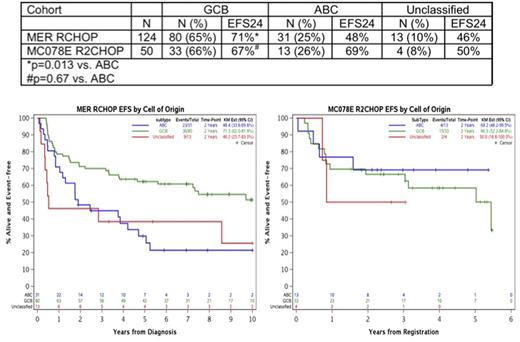Abstract
Background: We previously reported that Lenalidomide combined with R-CHOP (R2CHOP) has significant activity in non-GCB (non-germinal center B-cell) subtype of DLBCL as defined by immunohistochemistry (IHC) using Hans algorithm (J Clin Oncol. 2015 Jan 20;33(3):251-7). However, defining non-GCB subtype of DLBCL by IHC as opposed to the "gold standard" gene expression profiling (GEP) is subject to technical limitations and its prognostic value has not reproduced in some recently published studies. In addition, recent reports questioned prognostic value of GEP in prospective clinical trials as opposed to initial reports from retrospective case series. To address these concerns, we assessed outcomes by cell of origin (COO) as determined via GEP using NanoString Lymphoma Subtyping Test (LST) on formalin-fixed paraffin-embedded (FFPE) tissue on patients enrolled in a phase 2 study of R2CHOP and an independent comparison cohort of patients treated with RCHOP alone.
Methods: Eligible patients for R2CHOP phase 2 study MC078E were adults with newly diagnosed, untreated, stages II-IV CD20 positive DLBCL. Patients received oral lenalidomide 25 mg days 1-10 with standard dose R-CHOP every 21 days for 6 cycles. All patients received pegfilgrastim on day 2 of each cycle and aspirin prophylaxis. DLBCL molecular subtype was determined by GEP using NanoString LST, a multiplexed digital gene expression assay performed on the nCounter® Dx Analysis System and reported as GCB vs ABC vs unclassified. A comparison cohort of RCHOP treated DLBCL patients was generated from the prospectively enrolled Mayo Clinic component of the Lymphoma SPORE Molecular Epidemiology Resource (MER). MER patients meeting the same inclusion criteria as MC078E with available tissue were selected based via matching on age, stage, and IPI to the MC078E patients. Event-free survival was defined as time from diagnosis (MER) or study registration (MC078E) to progression, re-treatment, or death. EFS24 was defined as being event-free at 24 months. Associations between COO and outcome were assessed via log-rank tests due to censoring for EFS24.
Results: 50 MC078E R2CHOP patients enrolled between 2008 and 2013,124 matched MER RCHOP patients diagnosed between 2003 and 2012 were assessed for COO. Median follow up in 70 patients still alive was 7.9 years (1.9-13.0) in RCHOP treated patients and 4.4 years (1.9-5.5) for 24 in R2CHOP treated patients still alive. Median age was 65 years (range 35-89) in RCHOP treated patients and 69 years (22-87) in R2CHOP patients (p=0.485). 53 RCHOP treated patients (43%) and 31 R2CHOP treated patients (62%) had intermediate-high or high IPI (p=0.021). COO was GCB, ABC, and unclassified DLBCL subtype in 80, 31 and 13 patients in the 124 RCHOP cohort and 33, 13 and 4 patients in the R2CHOP treated patients, respectively (see table). EFS24 was inferior for ABC (48%) compared to GCB DLBCL 71% in MER RCHOP treated patients (p=0.013). In contrast, in R2CHOP treated pts, EFS24 was not different between ABC vs GCB DLBCL 69% vs 67% (p= 0.674).
Conclusion: Cell of origin classification of DLBCL determined by NanoString LST remains prognostic in a series of prospectively enrolled DLBCL patients treated with RCHOP. R2CHOP shows promising efficacy in ABC DLBCL as defined by NanoString LST, where the addition of lenalidomide to RCHOP appears to mitigate the negative impact of an ABC molecular subtype on the outcome.
Nowakowski:Morphosys: Research Funding; Bayer: Consultancy, Research Funding; Celgene: Research Funding. Maurer:Kite Pharma: Research Funding; Celgene: Research Funding. Storhoff:NanoString Technologies, Inc.: Employment, Other: Stock option. Dennis:NanoString Technologies, Inc.: Employment, Other: Stock option. Gandhi:Celgene Corporation: Employment, Equity Ownership. Thakurta:Celgene: Employment, Equity Ownership. Hagner:Celgene Corporation: Employment, Equity Ownership. Rimsza:NCI/NIH: Patents & Royalties: L.M. Rimsza is a co-inventor on a provisional patent, owned by the NCI of the NIH, using Nanostring technology for determining cell of origin in DLBCL..
Author notes
Asterisk with author names denotes non-ASH members.


